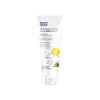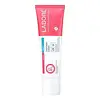What's inside
What's inside
 Key Ingredients
Key Ingredients

 Benefits
Benefits

 Concerns
Concerns

 Ingredients Side-by-side
Ingredients Side-by-side

Water
Skin ConditioningZinc Oxide
Cosmetic ColorantDibutyl Adipate
EmollientTitanium Dioxide
Cosmetic ColorantIsononyl Isononanoate
EmollientCetyl Alcohol
EmollientNiacinamide
SmoothingCetearyl Alcohol
EmollientAvena Sativa Kernel Flour
AbrasiveC12-15 Alkyl Benzoate
AntimicrobialGlycerin
HumectantJojoba Esters
EmollientGlyceryl Stearate
EmollientAllantoin
Skin ConditioningCaprylic/Capric Triglyceride
MaskingAluminum Hydroxide
EmollientTriethoxycaprylylsilane
Polyhydroxystearic Acid
EmulsifyingStearic Acid
CleansingHelianthus Annuus Seed Wax
Skin ConditioningSodium Stearoyl Glutamate
CleansingBisabolol
MaskingTocopheryl Acetate
AntioxidantCitric Acid
BufferingSodium Hyaluronate
HumectantLavandula Angustifolia Oil
MaskingCitrus Medica Peel Oil
Sodium Benzoate
MaskingPotassium Sorbate
PreservativeXanthan Gum
EmulsifyingCeramide NP
Skin ConditioningCeramide AP
Skin ConditioningPhytosphingosine
Skin ConditioningCholesterol
EmollientSodium Lauroyl Lactylate
EmulsifyingCeramide EOP
Skin ConditioningPolyglycerin-3
HumectantEthylhexylglycerin
Skin ConditioningCarbomer
Emulsion StabilisingWater, Zinc Oxide, Dibutyl Adipate, Titanium Dioxide, Isononyl Isononanoate, Cetyl Alcohol, Niacinamide, Cetearyl Alcohol, Avena Sativa Kernel Flour, C12-15 Alkyl Benzoate, Glycerin, Jojoba Esters, Glyceryl Stearate, Allantoin, Caprylic/Capric Triglyceride, Aluminum Hydroxide, Triethoxycaprylylsilane, Polyhydroxystearic Acid, Stearic Acid, Helianthus Annuus Seed Wax, Sodium Stearoyl Glutamate, Bisabolol, Tocopheryl Acetate, Citric Acid, Sodium Hyaluronate, Lavandula Angustifolia Oil, Citrus Medica Peel Oil, Sodium Benzoate, Potassium Sorbate, Xanthan Gum, Ceramide NP, Ceramide AP, Phytosphingosine, Cholesterol, Sodium Lauroyl Lactylate, Ceramide EOP, Polyglycerin-3, Ethylhexylglycerin, Carbomer
Water
Skin ConditioningGlycerin
HumectantSqualane
EmollientCetearyl Alcohol
EmollientPetrolatum
EmollientDimethicone
EmollientBifida Ferment Lysate
Skin ConditioningPropanediol
SolventHydroxyethyl Acrylate/Sodium Acryloyldimethyl Taurate Copolymer
Emulsion StabilisingCetearyl Glucoside
EmulsifyingAllantoin
Skin ConditioningBisabolol
Masking1,2-Hexanediol
Skin ConditioningDipotassium Glycyrrhizate
HumectantXanthan Gum
EmulsifyingCaprylic/Capric Triglyceride
MaskingChlorphenesin
AntimicrobialCaprylhydroxamic Acid
Tetrasodium EDTA
Deoxyphytantriyl Palmitamide Mea
Skin ConditioningHydrogenated Lecithin
EmulsifyingCeramide NP
Skin ConditioningCholesterol
EmollientLactobacillus
Skin ConditioningGlucose
HumectantCyanocobalamin
Skin ConditioningAlgin
MaskingPotassium Sorbate
PreservativeSodium Benzoate
MaskingCalcium Chloride
AstringentWater, Glycerin, Squalane, Cetearyl Alcohol, Petrolatum, Dimethicone, Bifida Ferment Lysate, Propanediol, Hydroxyethyl Acrylate/Sodium Acryloyldimethyl Taurate Copolymer, Cetearyl Glucoside, Allantoin, Bisabolol, 1,2-Hexanediol, Dipotassium Glycyrrhizate, Xanthan Gum, Caprylic/Capric Triglyceride, Chlorphenesin, Caprylhydroxamic Acid, Tetrasodium EDTA, Deoxyphytantriyl Palmitamide Mea, Hydrogenated Lecithin, Ceramide NP, Cholesterol, Lactobacillus, Glucose, Cyanocobalamin, Algin, Potassium Sorbate, Sodium Benzoate, Calcium Chloride
 Reviews
Reviews

Ingredients Explained
These ingredients are found in both products.
Ingredients higher up in an ingredient list are typically present in a larger amount.
Allantoin is a soothing ingredient known for its protective and moisturizingg properties. Because of this, it is often added to products with strong active ingredients.
Studies show higher concentrations of this ingredient can promote wound healing.
Though it can be derived from the comfrey plant, allantoin is produced synthetically for cosmetic products to ensure purity.
Learn more about AllantoinBisabolol is famous for its skin soothing properties. It does this by blocking inflammatory signals, helping to reduce your body's reaction to irritation.
This ingredient also interferes with the process of hyperpigmentation. This can help with reducing dark spots and uneven tone.
Bisabolol is an antioxidant. Antioxidants help fight free-radicals. Free-radicals are molecules that may damage your skin cells. By fighting these free-radicals, Bisabolol may slow down signs of aging.
Studies have shown Bisabolol to have antimicrobial properties and may be a fungicide. These properties help preserve a product's shelf life.
All these properties makes bisabolol a great skin barrier helper ingredient.
Bisabolol also helps the absorption of other ingredients.
Note: Synthetic Bisabolol has been shown to be less effective.
Learn more about BisabololThis ingredient is an emollient, solvent, and texture enhancer. It is considered a skin-softener by helping the skin prevent moisture loss.
It helps thicken a product's formula and makes it easier to spread by dissolving clumping compounds.
Caprylic Triglyceride is made by combining glycerin with coconut oil, forming a clear liquid.
While there is an assumption Caprylic Triglyceride can clog pores due to it being derived from coconut oil, there is no research supporting this.
Learn more about Caprylic/Capric TriglycerideCeramide NP is a type of ceramide and formally known as ceramide 3.
Ceramides are intercellular lipids naturally found in our skin that bonds dead skin cells together to create a barrier. They are known for their ability to hold water and thus are a great ingredient for dry skin.
Ceramides are an important building block for our skin barrier. A stronger barrier helps the skin look more firm and hydrated. By bolstering the skin ceramides act as a barrier against irritating ingredients. This can help with inflammation as well.
If you would like to eat ceramides, sweet potatoes contain a small amount.
Read more about other common types of ceramides here:
Ceramide AP
Ceramide EOP
Cetearyl alcohol is a mixture of two fatty alcohols: cetyl alcohol and stearyl alcohol. It is mainly used as an emulsifier. Emulsifiers help prevent the separation of oils and products. Due to its composition, it can also be used to thicken a product or help create foam.
Cetearyl alcohol is an emollient. Emollients help soothe and hydrate the skin by trapping moisture.
Studies show Cetearyl alcohol is non-toxic and non-irritating. The FDA allows products labeled "alcohol-free" to have fatty alcohols.
This ingredient is usually derived from plant oils such as palm, vegetable, or coconut oils. There is debate on whether this ingredient will cause acne.
Due to the fatty acid base, this ingredient may not be Malassezia folliculitis safe.
Learn more about Cetearyl AlcoholCholesterol is a class of organic molecules called lipids. It helps hydrate your skin and is essential to having a healthy skin barrier.
Our skin naturally contains cholesterol in the outermost layer. Besides cholesterol, it also contains ceramides and fatty acids. Cholesterol makes up about 1/4 of your skin's outer layer and barrier. Your skin barrier is responsible for keeping allergens and microbes out. Having a healthy skin barrier is also responsible for keeping your skin firm and plump.
Our bodies use cholestrol to create vitamin D, steroid hormones, and more.
Learn more about CholesterolGlycerin is already naturally found in your skin. It helps moisturize and protect your skin.
A study from 2016 found glycerin to be more effective as a humectant than AHAs and hyaluronic acid.
As a humectant, it helps the skin stay hydrated by pulling moisture to your skin. The low molecular weight of glycerin allows it to pull moisture into the deeper layers of your skin.
Hydrated skin improves your skin barrier; Your skin barrier helps protect against irritants and bacteria.
Glycerin has also been found to have antimicrobial and antiviral properties. Due to these properties, glycerin is often used in wound and burn treatments.
In cosmetics, glycerin is usually derived from plants such as soybean or palm. However, it can also be sourced from animals, such as tallow or animal fat.
This ingredient is organic, colorless, odorless, and non-toxic.
Glycerin is the name for this ingredient in American English. British English uses Glycerol/Glycerine.
Learn more about GlycerinPotassium Sorbate is a preservative used to prevent yeast and mold in products. It is commonly found in both cosmetic and food products.
This ingredient comes from potassium salt derived from sorbic acid. Sorbic acid is a natural antibiotic and effective against fungus.
Both potassium sorbate and sorbic acid can be found in baked goods, cheeses, dried meats, dried fruit, ice cream, pickles, wine, yogurt, and more.
You'll often find this ingredient used with other preservatives.
Learn more about Potassium SorbateSodium Benzoate is a preservative. It's used in both cosmetic and food products to inhibit the growth of mold and bacteria. It is typically produced synthetically.
Both the US FDA and EU Health Committee have approved the use of sodium benzoate. In the US, levels of 0.1% (of the total product) are allowed.
Sodium benzoate works as a preservative by inhibiting the growth of bacteria inside of cells. It prevents the cell from fermenting a type of sugar using an enzyme called phosphofructokinase.
It is the salt of benzoic acid. Foods containing sodium benzoate include soda, salad dressings, condiments, fruit juices, wines, and snack foods.
Studies for using ascorbic acid and sodium benzoate in cosmetics are lacking, especially in skincare routines with multiple steps.
We always recommend speaking with a professional, such as a dermatologist, if you have any concerns.
Learn more about Sodium BenzoateWater. It's the most common cosmetic ingredient of all. You'll usually see it at the top of ingredient lists, meaning that it makes up the largest part of the product.
So why is it so popular? Water most often acts as a solvent - this means that it helps dissolve other ingredients into the formulation.
You'll also recognize water as that liquid we all need to stay alive. If you see this, drink a glass of water. Stay hydrated!
Learn more about WaterXanthan gum is used as a stabilizer and thickener within cosmetic products. It helps give products a sticky, thick feeling - preventing them from being too runny.
On the technical side of things, xanthan gum is a polysaccharide - a combination consisting of multiple sugar molecules bonded together.
Xanthan gum is a pretty common and great ingredient. It is a natural, non-toxic, non-irritating ingredient that is also commonly used in food products.
Learn more about Xanthan Gum